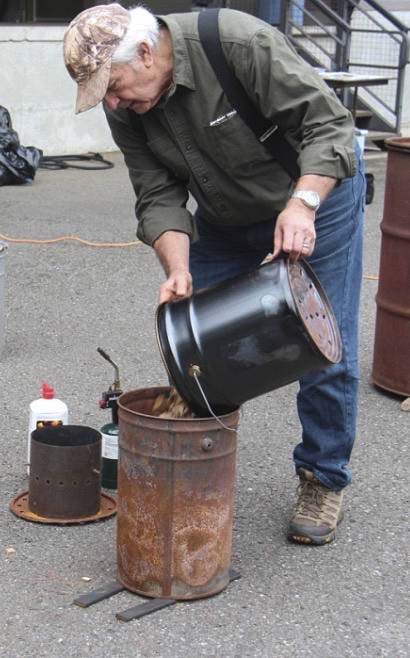Biochar
Several interested parties gathered at the ONRC Thursday afternoon to hear from Sequim resident Norman Baker, PhD. Baker had come to demonstrate the creation of Biochar material.
According to Baker:
Biochar is nothing more than charcoal made from woody waste at about 450 degrees C. About 30 percent of the wood can be made into biochar.
Biochar has enormous potential for our culture and economy, including diverse things like water filtration, the absorption of electromagnetic or radiofrequency energy, building construction, uses in clothing and electronics, air decontamination, pesticide remediation, heavy metal adsorption, medicines, sewage treatment, etc.
The remaining 70 percent of the wood is a complex mixture of gases, called syngas and oils, called synoils. The syngas can be used as a replacement for gasoline and the synoils can be used in diesel engines.
Both will be a significant part of our future for clean renewable energy. This is the future of sustainability for our environment, culture and economy.
The potential of biochar for environmental sensitivity and sustainability is simply enormous.
Although there is currently a lot of entrepreneurial interest in supplying biochar to the consumer, high-quality biochar can also be made at home and on the farm for organic food production. Research shows woody waste from our forests, which is normally simply burned and wasted, plus woody waste from our municipal waste stream, can be used sustainably to solve several problems in our society simply because all of these three major applications operate synergistically.
Currently, there is enormous interest in incorporating biochar into our soils.
There are two reasons for this.
First, it has the potential to restore depleted agricultural soils and to enhance organic agricultural and home vegetable garden productivity. Modern research shows several benefits- including crop production enhancement, methane reduction, nitrous oxide reduction, water holding capacity, greater fertilizer efficiency, and even heavy metal remediation and pesticide degradation in contaminated soils.
Second and simultaneously, biochar has a half-life of 1100 years. This means 100 pounds of biochar put into the soil, slowly degrades over 1,100 years to 50 pounds and then to 25 pounds in another 1100 years. In terms of carbon sequestration to fight global warming, this is essentially forever. Every pound of biochar incorporated into this soil sequesters 3.00 pounds of C02 from our atmosphere.



